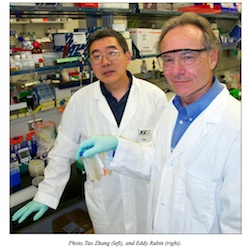Researchers from the U.S. Department of Energy (DOE) Joint Genome Institute (JGI) and the Joint BioEnergy Institute (JBEI) at DOE’s Lawrence Berkeley National Laboratory are trying to discover salt-loving organisms that may be more efficient in treating biomass and improve sugar yield for biofuel production. The class of solvents known as ionic liquids, are liquid forms of salt that will inactivate enzymes by interfering with the folding of polypeptides—the building-blocks of proteins. These solvents are useful for breaking down biomass; however, they can also hinder the ability of cellulases used to produce sugars after pretreatment.
 To break this code, the researchers are turning to those found in the complete genome sequences of halophilic (salt-tolerant) organisms. As a test of this bioenergy-related application of DNA sequencing and enzyme discovery, researchers led by the Director of the DOE JGI, Eddy Rubin, and the Vice-President of the JBEI Deconstruction Division, Blake Simmons, employed a cellulose-degrading enzyme from a salt-tolerant microbe that was isolated from the Great Salt Lake.
To break this code, the researchers are turning to those found in the complete genome sequences of halophilic (salt-tolerant) organisms. As a test of this bioenergy-related application of DNA sequencing and enzyme discovery, researchers led by the Director of the DOE JGI, Eddy Rubin, and the Vice-President of the JBEI Deconstruction Division, Blake Simmons, employed a cellulose-degrading enzyme from a salt-tolerant microbe that was isolated from the Great Salt Lake.
The microbe in question, Halorhabdus utahensis, is from the branch of the tree of life known as Archaea. It was isolated from the natural environment at the Great Salt Lake and sequenced as part of the Genomic Encyclopedia of Bacteria and Archaea (GEBA) project. The researchers believe that salt -tolerant enzymes may offer significant advantages over conventional enzymes. They can tolerate high temperatures and are resistant to ionic liquids.
“This is one of the only reports of salt-tolerant cellulases, and the only one that represents a true ‘genome-to-function’ relevant to ionic liquids from a halophilic environment,” said Simmons. “This strategy enhances the possibility of identifying true obligatory halophilic enzymes. This project has established a very important link between genomic science and the realization of enzymes that can handle very demanding chemical environments, such as those present in a biorefinery,” said Simmons.
Results of the study were published June 30, 2011 in Green Chemistry. The next step is for the research team to expand this research to develop a full complement of enzymes that are tailored for the ionic liquid process technology. Their ultimate goal is to demonstrate a complete biomass-to-sugar process, one they hope can enable the commercial viability of advanced biofuels.

